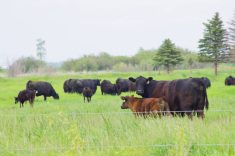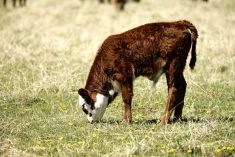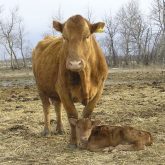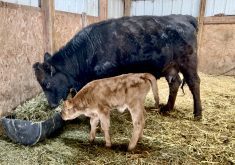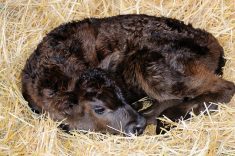Calving can be stressful for both people and animals. Preparation far in advance is one way producers can better ensure success for a safe and productive calving season.
“Some of that preparedness starts well before calving season, if you think about herd health programs or nutrition, or making sure cows are in good shape coming into calving. That’s important,” said Karin Schmid, beef production and extension lead with Alberta Beef Producers.
Cows that are too fat or too skinny are more likely to have calving problems.

“The next piece, of course, when you get a little closer to your calving season, is thinking a little bit about your equipment being in good shape,” she said. “The worst thing in the world is to be running around in the morning unable to find your calving chains.”
Read Also

Mosquito-borne virus could be devastating to sheep breeding operations
Cache Valley virus, a mosquito-borne disease that infects small ruminants, could be a devastating hit to small operations.
Producers should ensure the calving area is clean and in good shape. Doug Roxburgh, a first-generation cow-calf backgrounder near Rimbey who farms with his wife, agrees that preparation is key.
“That’s the big one, being prepared for everything and anything, even if it is something that you think could be off, that you wouldn’t expect to be the norm. I think it’s important to have all your bases covered for sure.
“Having all these things in place right off the get go makes the calving season go better for producers if they have their ducks in a row before they get started.”
Roxburgh recommends using a checklist of needed calving supplies, such as needles, gloves, milk replacer, colostrum, and vaccines.
“The big one for me prior to calving is having a proper nutrition program set up for your cows,” he said. “Make sure they’ve got all the adequate minerals and things, and they’ve got a good solid foundation coming into calving.”
Schmid agrees. Healthy calving depends a lot on herd health and nutrition, making sure animals are up to date with their vaccinations and following the label on vaccinations.
She recommends that producers source colostrum from their own herd and avoid dairy colostrum. Commercial colostrum is also an option. Using a bottle to deliver it is better than using a tube because calves absorb it more readly. Knowing when to get involved in the birthing process is important too.
“Thinking about knowing or brushing up on when to intervene during difficult calving. Too late is usually a bad scenario. Too early can cause damage to the cow’s reproductive system,” she said.
Schmid recommends building a calving kit with cleaning materials, disinfectant, lubricant, chains, gloves, syringes, a bucket and whatever else might be needed. All these things should be in one place and easy to access.
It’s a good idea to have two tube feeders; one for sick calves and the other to deliver colostrum to healthy calves that can’t nurse for some reason. Schmid said the Beef Cattle Research Council has good online resources called the Calf 911 series.
“If you expect calving to start March 1, you want to make sure you have everything ready by the middle of February. That way you can deal with the one that calves a little early, and you’re not caught off guard, scrambling around.”

Healthy calving starts a long time in advance, said Roxburgh. He encourages producers to get feed tested to ensure proper herd nutrition. That goes hand in hand with a good vaccination program.
“The better your cows are fed, the better those vaccines are going to work.”
Roxburgh also recommends forming a solid vet/client relationship long before calving season starts.
It’s important to calve in a clean area, and the Sandhills method can be used for that. It involves separation between newborn calves and those more than two weeks old, to reduce the risk of disease development.
Self care
Producers should also take precautions to protect their own health during calving season.
“A number of pathogens that we come into contact with as producers can also make us sick,” said Schmid.
”A good example of that is crypto. You want to make sure you’re thinking about making sure you’re washing your hands. Make sure you’re wearing gloves as appropriate. If you’re coming into contact with fecal material or birthing fluids, make sure you try to clean that up, so you don’t make yourself sick as well.
“There’s a mental component to calving season too. I think it’s important that we’re taking care of ourselves. You can’t take care of your calves or your cows if you’re not taking care of yourself as well.”
Roxburgh said that doesn’t have to be difficult.
“It can be simple things like just meal preparation. As producers, we get busy when we’re calving. It’s a busy time of year. In a lot of cases, our own personal health gets put on the back burner. Just having a good mindset really helps you set up for success.”
Sleep when you can and use technology, added Schmid.
“I think this is where technology has made a big difference for some of those folks with remote camera systems. You can monitor your calving area instead of getting all bundled up and going out every two hours to check. You can just walk to the monitor and there’s a little less disruption on your sleep patterns.
“Don’t forget to eat and drink a lot of fluids. I think it can be easy to get wrapped up in the hectic nature and forget some of the things,” said Schmid.




